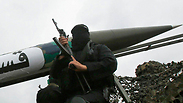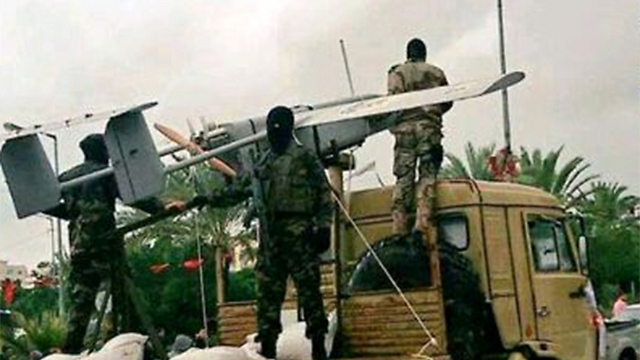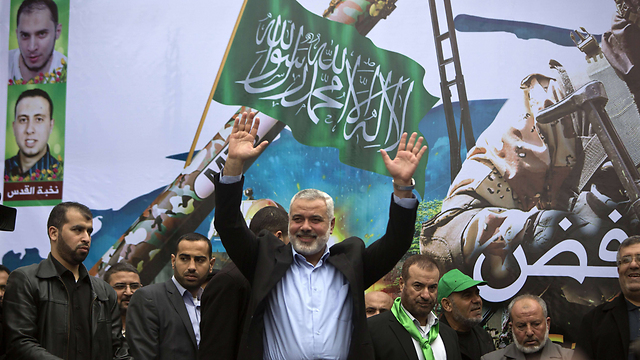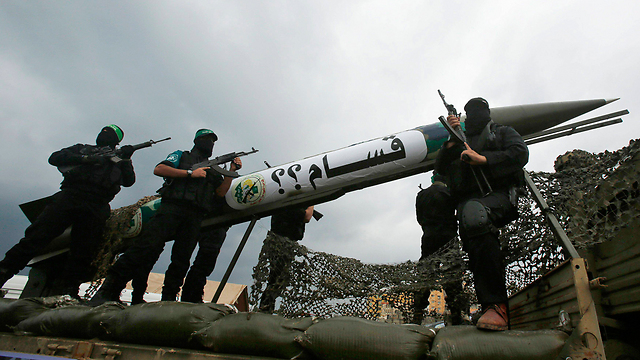
In Gaza, Hamas shows off weapons and girds for fresh fight
With no rehabilitation in sight and promised money not forthcoming, Gaza's militant rulers are testing rockets and boasting of their tunnels, even as the Strip's residents pay the price.
Three months after Operation Protective Edge, and the Gaza Strip is still licking its wounds. Tens of thousands of residents whose homes were destroyed or severely damaged in the fighting are still residing in UNRWA facilities and others are housed in tents - in the middle of winter. Rehabilitation is slow, and the Strip's 1.7 million citizens are paying for the battles of ego between Fatah and Hamas, with supplies running low and unemployment "holding" at a frustrating 45 percent.
The money pledged at the international conference in Cairo - more than $5 billion - exists only on paper. Palestinian Prime Minister Rami Hamdallah set out a few weeks ago for a round of visits to the Gulf states, trying to ensure that the promised assistance translated into action. But for the moment, the amount actually transferred is negligible.
To make matters worse, Fatah and Hamas are trading verbal blows that only delay rehabilitation. Palestinian Authority President Mahmoud Abbas has blamed Hamas for the delay, saying it is due to the organization's refusal to transfer control of the crossings to his Presidential Guard, despite promising to do so.
Hamas is well aware of the public's gloomy atmosphere, and while it does not fear a popular revolt, its leaders point the finger are to the two sources it can attack: Israel and the Palestinian Authority. For example, Hamas officials have threatened almost daily that the current situation will lead to an explosion for which Israel will be responsible. A fresh escalation may, Hamas believes, tilt civil pressure back towards Israel and put the Gaza issue back on the international agenda, after diminishing as time passed.
The recovery mechanism, in cooperation with Israel and run by the UN, began to operate at the end of November, but the non-transfer of funds has led to a large gap between what is happening and what is needed on the ground. In addition, Hamas has been "caught" several times collecting tax on cement entering the Gaza Strip, and only threats to halt the transfers stopped the taxation.
To meet any significant military action so soon after the last operation, Hamas is trying to restore its fighting capabilities. The organization claimed it has renewed its excavation of attack tunnels toward Israel, and members of group's military wing have already conducted several tours with the members of the Arab media. The journalists are presented with what Hamas says are tunnels that were undamaged in the operation, or those who excavation continues at full steam. Bricks made from reddish mud negate the need for cement and are used, according to the military wing, to line the new tunnels.
According to an Egyptian report, Hamas is investing $140 million a year in digging tunnels. There are 12 thousand people employed in the digging; they work only with their hands, for fear that the noise of drilling would expose the excavation. The cost of a tunnel in the Rafah border area, for example, is estimated at some $100 thousand, and the work takes months, sometimes even years.
At the same time, Hamas has revived its rocket production system, which was damaged but not completely destroyed during the operation. It conducts test fires out to sea every week; Hamas official Musa Abu Marzouk has publicly admitted that the tests are taking place, and stresses that the ceasefire agreement with Israel does not preclude a ban on weapons testing.
To demonstrate the extent to which its capabilities were unharmed by the IDF operation, the Hamas military wing this week held a spectacle to show off its arsenal, including the R-160 rocket, which has a range of 150 km, which was launched during the summer conflict and fell on the outskirts of Haifa. The rocket is named for Hamas leader Abdel Aziz Rantisi, killed by Israel in 2004. The highlight of the parade was a display by the Iranian-made UAV "Ghods Ababil", which Hamas says poses a challenge to Israel.
The parade was designed to demonstrate to the Gaza population Hamas' exceptional power, and prove that months of war had not broken its strength or capabilities. It was also intended to signal to Israel and the Arab world that the organization could endure another major round of escalation and battle, if its demands were not met.













